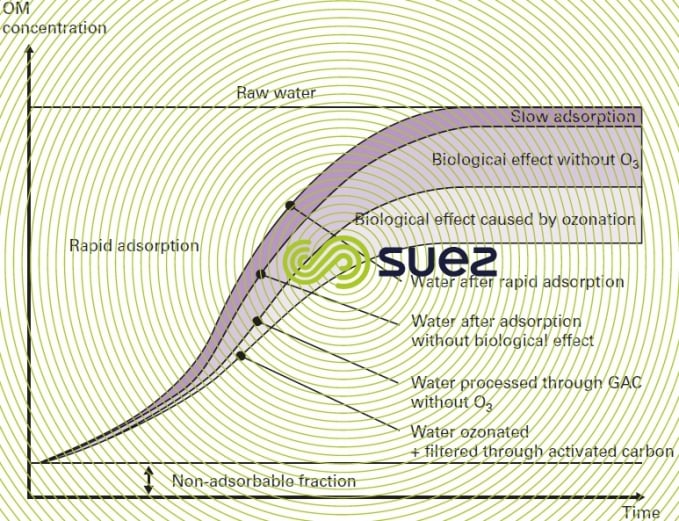the BAC (biological activated carbon concept)
Reading time:Granular activated carbon (GAC) is a support material that is very favourable to the development of some bacteria that are widely found in the environment such as nitrifying bacteria or heterotrophic bacteria responsible for metabolising biodegradable organic matter.
There are many factors encouraging the attachment, development and metabolism of these bacteria:
- extracellular polymers secreted by the bacteria;
- grain surface unevenness coupled with a physical-chemical type adsorption capability (similar to that of organic molecules); these properties allow the bacteria to remain attached to the GAC even in the presence of a high shear force of the type that occurs when water and air are used to wash the filter;
- bacteria will be protected against chlorine, when chlorine is found in the water to be treated or in wash water, and against certain toxic substances that will also attach to the GAC instead of remaining dissolved in the water;
- organic molecules used as bacteria nutrient and trapped in the GAC pores.
Therefore, when the bacteria first attach to the GAC, this takes place very rapidly; subsequently, a balanced bacteria population is achieved and needs to be controlled through sufficiently frequent washes (i.e. at approximately weekly intervals); these washes are also necessary to ensure that a population of micro-invertebrates, feeding off these bacteria, does not colonise the GAC.
The quantity of attached bacterial biomass, far greater than that of a sand filter without, however, reaching the levels found in a biofilters using biolite, explains how a biological action can be added to a purely physico-chemical adsorption effect. This dual action appears in figure 44 that illustrates the change in TOC concentration in treated water as a function of time; we can observe:
- a slight TOC residue that cannot be adsorbed over new GAC in treated water;
- a rapid adsorption effect that quickly reaches saturation but that is extended by a slow adsorption effect (organic molecules migrating inside GAC pores); this effect means that we can reach a TOC plateau purely through physico-chemical mode;
- an additional TOC reduction by biological means, leading to a plateau that is noticeably lower than the previous one; this effect appears to be independent of the type of GAC even when the latter has been specifically designed as a substrate for a biological activity; it concerns BDOC removal.
The kinetics of biochemical reactions are closely linked to water temperature: For instance, for the same TOC abatement, we need almost double the contact time when the temperature drops from 20°C to 8°C even when the attached bacterial biomass is, on average, identical at the two temperatures.
After a sufficient acclimatisation period, more complex compounds such as some organochlorine products, can be metabolised by bacteria attached to a GAC filter. However, this action remains limited if water is injected into the GAC without having first applied the appropriate preliminary treatment; on the other hand, the biological effect exerted by a GAC filter will be considerably enhanced by preliminary ozonation; in effect:
- ozone oxides products that have fast oxidation kinetics; therefore these products no longer have to be adsorbed over the GAC thus noticeably extending its service life (prior to replacement or thermal regeneration);
- additionally, ozone, by "fracturing" many complex molecules (see the oxidants and disinfectants), renders these biodegradable; thus the biological elimination of organic matter increases more than if no ozonation had been applied (figure 44) and it can be assumed that the GAC filter has, in fact, become a biological activated carbon (BAC) filter by virtue of this design and operating method.



The [O3 + GAC] pairing also produces a better elimination:
- of tastes and odours;
- of organic molecules that act as "precursors", encouraging the formation of THM after chlorination and, more generally, oxidation by-products after the various disinfectants have taken effect;
- and most mineral micro (heavy metals) and organic (pesticides, phenols, hydrocarbons, detergents, algal toxins…) pollution.
That is why many modern water treatment plants include this type of polishing downstream from clarification (see polishing: removal of organic matter and micro-pollutants).
Bookmark tool
Click on the bookmark tool, highlight the last read paragraph to continue your reading later












